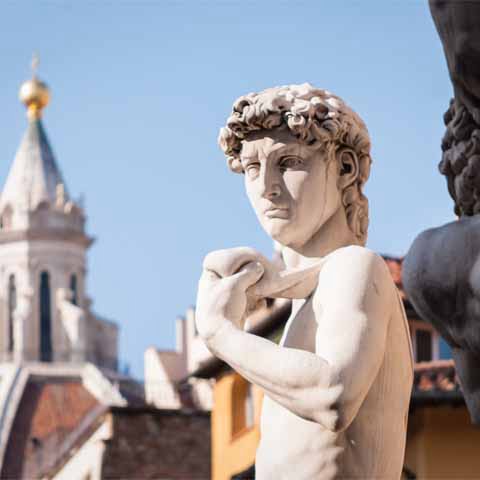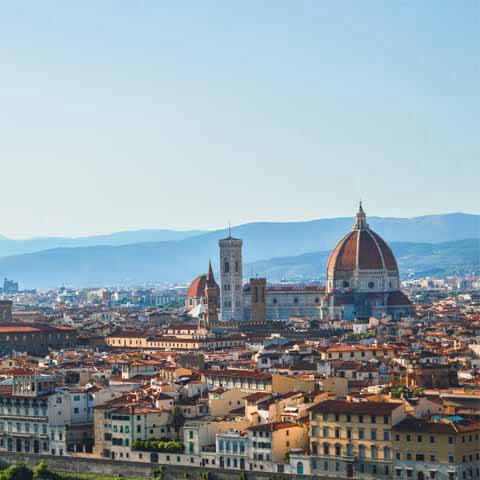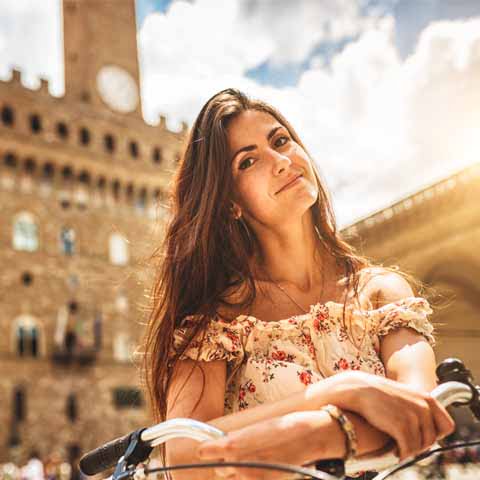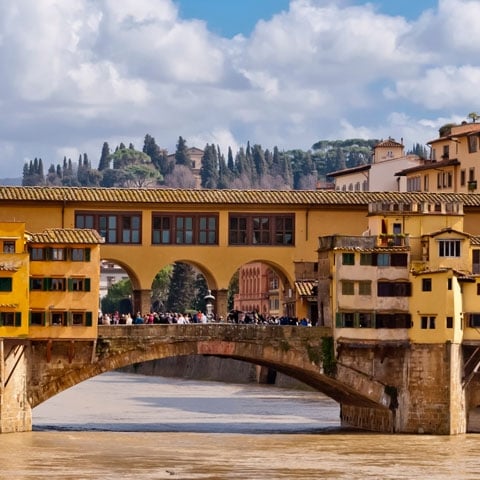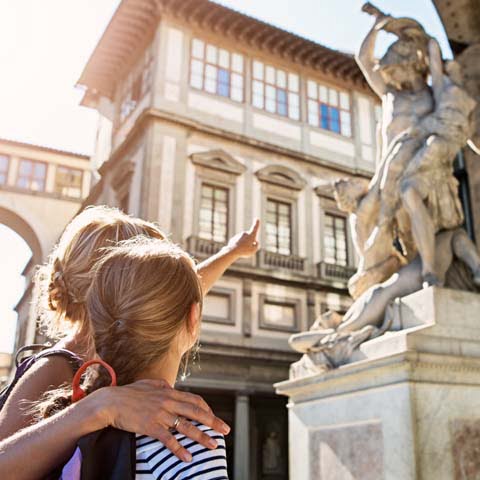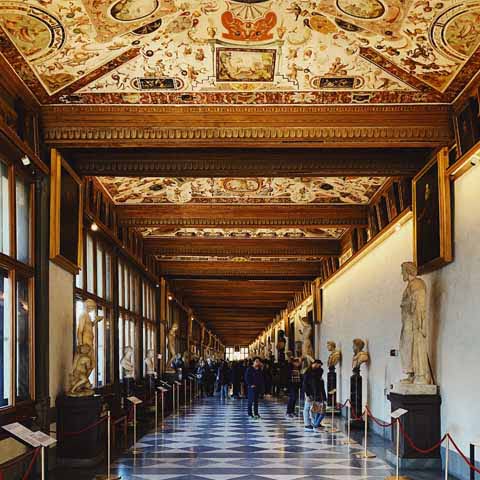Located in the Tuscany region of Italy, Florence is a captivating Italy destination that Mark Twain once described as a “city of dreams.” With its abundance of timeless art, rustic Tuscan cuisine, incredible boutique shopping, and mesmerizing views at every turn, the city of Florence is nothing short of spectacular. Known worldwide as the birthplace of the Renaissance, Florence embodies the spirit of Italy’s past and has managed to preserve it for nearly 700 years. With over 350,000 who call the city home, and nearly one million who reside in its surrounding metropolitan area, Florence skillfully fuses the past with the present, creating a unique time capsule of ancient aesthetics housed within a hustling, bustling world of modern-day Italy.
Containing a wealth of preserved artistic and architectural masterpieces, the city is home to the world’s most significant concentration of art, according to UNESCO, a UN organization that designates world heritage sites to preserve the most important cultural locations and artifacts. With a near countless number of art galleries and over 45 museums – including the Galleria degli Uffizi (Uffizi Gallery), the world’s best collection of Italian Renaissance art, and the Galleria dell’Accademia (Accademia Gallery), home to the legendary statue of David – it is no wonder why the city captures the hearts and imaginations of all who visit. From the ancient churches and stunning buildings that line the city streets to the priceless artistic masterpieces created by Michelangelo, Botticelli, and Giotto housed within Florence’s galleries, the city is bursting with art and culture.Florence’s influence can be felt in more than just the world of art. The capital of the region of Tuscany, Florence is the birthplace of the Italian language. It was famed Italian poet Dante Alighieri who advocated for the use of vernacular language in literature. For his most important works, including the Divine Comedy, Dante wrote in the Florentine dialect, rather than in Latin. This inspired later influential writers, such as Boccaccio and Petrarch, to follow suit, and eventually standard Italian was born from the Florentine dialect. With its rich history and incomparable influence on modern Italian life, Florence certainly changed the way that most view Italy.
The most iconic and historical elements of the city are heavily concentrated into a small area, making Florence an ideal travel destination. Much of Florence’s sightseeing can be done on foot since the majority of the city’s prized sites are within walking distance. The streets are often filled with pedestrians and speeding mopeds while locals and tourists alike travel to sought after sites such as the Piazza della Signoria, Florence’s heart and the political center of the city since the fourteenth century. This L-shaped town square is the center of activity for Florentines and visitors alike. Nearby one will find the Palazzo Vecchio, the city’s town hall, as well as Piazza del Duomo, home of the iconic Florence Cathedral with Brunelleschi’s Dome.
Each view and experience throughout Florence is more magical and culturally enriching than the next. With a city as spellbinding and magical as Florence, it is no surprise that more than 15 million visitors are compelled to visit every year, and it is considered one of the world’s most highly desired travel destinations.
GEOGRAPHY & CLIMATE OF FLORENCE
Florence is located in Northern Tuscany. Practically in the heart of Italy’s boot-shaped peninsula, Florence is situated in a basin and is surrounded by hills. With Emilia Romagna to the north and east, the city of Arezzo to the southeast, the city of Siena to the south, and the cities of Prato, Pistoia, Lucca, and Pisa to the west, Florence is a cultural hub characterized by a variety of traditions. Its geography is varied as well, boasting hills, valleys, rivers, streams, and views of the Apennine mountains. However, the city’s geography is primarily marked by one of the important rivers in Italy, the Arno. Originating from Mount Falterona in the Apennines, the Arno river is 150 miles long and practically splits the city in half. Running below famous Florentine bridges – the Ponte Vecchio and Ponte Santa Trinità – the Arno river often appears as the main subject of many iconic photographs of the beautiful city. The hills that surround Florence also make for eye catching panoramas in stunning areas such as Fiesole, Cercina, Settignano, and Arcetri. Other unique landscape views can be found in areas such as Greve in Chianti, where endless vineyards stretch as far as the eye can see, and Montespertoli and Certaldo, which both encapsulate the quintessential Tuscan landscape.
The climate of Florence is considered to be temperate and humid. During the summer months, Florence can be both hot and humid, particularly within the historical city center. Winters can be cold, and in some parts of the metropolitan area, snow flurries are not abnormal. While rainier than summer and winter, Florence’s autumns and springs are temperate and enjoyable. Truly, there is never really a bad time to visit Florence.
WHEN IN FLORENCE
The best way to experience Florence is to immerse oneself into the local life and culture. This is done best by walking the streets and experiencing the vibrancy and life of the city firsthand. Florence is a city that expresses itself through its architecture, landscape views, and sheer artistic essence that permeates throughout the city’s streets. Taking a stroll to one of Florence’s piazze is the perfect way to soak in the city. Florentines are friendly and welcoming in their beloved city squares, often meeting other locals there for an aperitivo or simply to catch up.
One may also find themselves in one of Florence’s many markets, which are an important part of Florentine life. From the fruit and vegetable market of Novoli to the historic Mercato Centrale and Mercato di San Lorenzo where shoppers can purchase produce and other staples of Tuscan cuisine as well as leather goods and souvenirs, markets are a place where handmade and local products are as abundant as the crowds who flock to them. Though navigating the busy lanes and squares can take time, there is no better way to soak in Florentine life than to slow down, look around, and be one with Italy.
After a stroll around town, visit one of Florence’s many cafés, restaurants, or bars to indulge in classic Florentine cuisine. When in Tuscany, dine as the Tuscans do! Tuscany’s iconic rustic cuisine is characterized by its simple yet flavorful recipes that are handcrafted with local, seasonal ingredients. Since the cuisine is derived from “cucina povera,” or Italian peasant culture, there is a deep appreciation and respect for food throughout Florence that is evident in every snack or meal. Whether sitting down for a multicourse meal or grabbing an espresso and some biscotti from a café, eating time is cherished in Florence as a moment to stop and truly savor both the nourishment of one’s body as well as the invaluable time spent with friends, family, or even strangers at the table.
One cannot visit a city that is called “the Cradle of the Renaissance” without experiencing Italian Renaissance art. Luckily, Florence is home to some of the world’s most important museums and art galleries. Tourists have been enamored by the city’s wealth of iconic pieces such as Michelangelo’s David and Botticelli’s The Birth of Venus for centuries. From the paintings in the largest museum complex in the city, Palazzo Pitti, to the many wonderful sculptures of the Bargello, Florence’s art scene is a true testament to human achievement in art.
To escape the busy city, one should not underestimate the beauty and wonder of Florence’s surrounding areas. Small towns on the outskirts of the city offer unique insight into the area’s history as well as their own special landmarks and views. Towns such as Fiesole, Certaldo, and Vinci – the closest town to the birthplace of Leonardo Da Vinci – are all spectacular examples of the richness of the Tuscan countryside. Renting a car for a day or scheduling a day with a private driver is a wonderful way to take in the area’s winding roads and rolling landscape.
Florence’s beauty is subtle, yet unparalleled. From its magnificent palaces, to its bustling squares, to the sheer volume of Renaissance art held within its famed museums, the irresistible heart and spirit of Florence can be felt throughout the entire city and its surrounding areas.
Travel Guides
Tuscany Region of Italy
Cities of Tuscany


